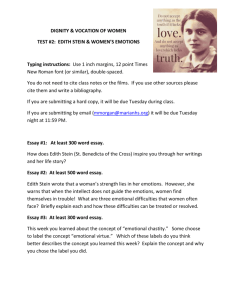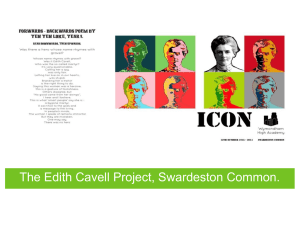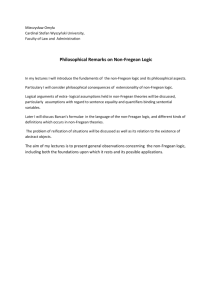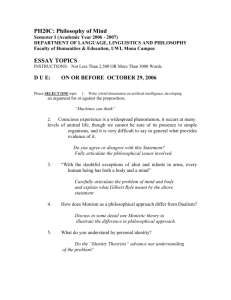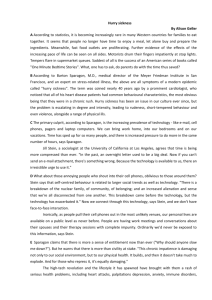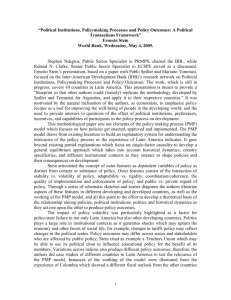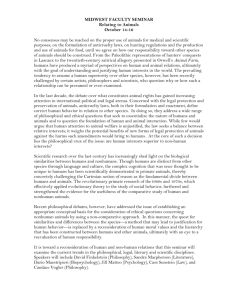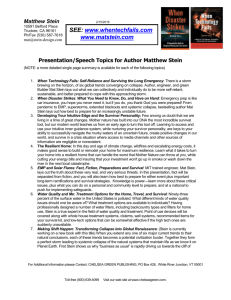What is a Human Person? — Recent Gender Theories and the
advertisement
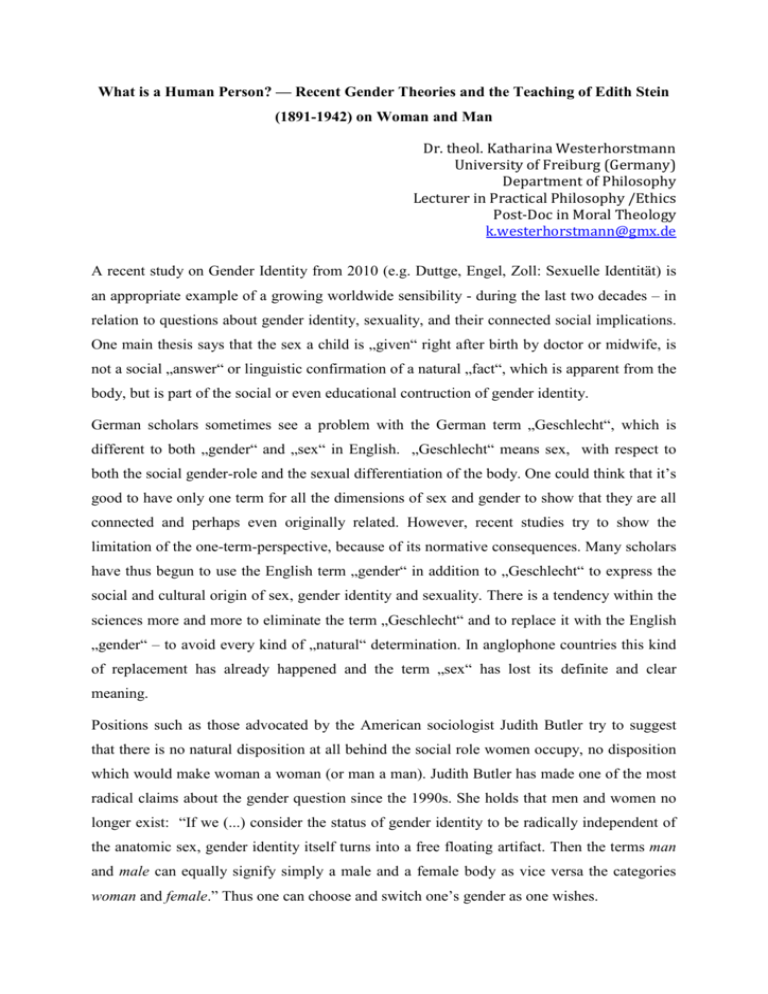
What is a Human Person? — Recent Gender Theories and the Teaching of Edith Stein (1891-1942) on Woman and Man Dr. theol. Katharina Westerhorstmann University of Freiburg (Germany) Department of Philosophy Lecturer in Practical Philosophy /Ethics Post-Doc in Moral Theology k.westerhorstmann@gmx.de A recent study on Gender Identity from 2010 (e.g. Duttge, Engel, Zoll: Sexuelle Identität) is an appropriate example of a growing worldwide sensibility - during the last two decades – in relation to questions about gender identity, sexuality, and their connected social implications. One main thesis says that the sex a child is „given“ right after birth by doctor or midwife, is not a social „answer“ or linguistic confirmation of a natural „fact“, which is apparent from the body, but is part of the social or even educational contruction of gender identity. German scholars sometimes see a problem with the German term „Geschlecht“, which is different to both „gender“ and „sex“ in English. „Geschlecht“ means sex, with respect to both the social gender-role and the sexual differentiation of the body. One could think that it’s good to have only one term for all the dimensions of sex and gender to show that they are all connected and perhaps even originally related. However, recent studies try to show the limitation of the one-term-perspective, because of its normative consequences. Many scholars have thus begun to use the English term „gender“ in addition to „Geschlecht“ to express the social and cultural origin of sex, gender identity and sexuality. There is a tendency within the sciences more and more to eliminate the term „Geschlecht“ and to replace it with the English „gender“ – to avoid every kind of „natural“ determination. In anglophone countries this kind of replacement has already happened and the term „sex“ has lost its definite and clear meaning. Positions such as those advocated by the American sociologist Judith Butler try to suggest that there is no natural disposition at all behind the social role women occupy, no disposition which would make woman a woman (or man a man). Judith Butler has made one of the most radical claims about the gender question since the 1990s. She holds that men and women no longer exist: “If we (...) consider the status of gender identity to be radically independent of the anatomic sex, gender identity itself turns into a free floating artifact. Then the terms man and male can equally signify simply a male and a female body as vice versa the categories woman and female.” Thus one can choose and switch one’s gender as one wishes. This claim, however, contradicts not only what appears to be the case (that biological sex is 98% clearly identifiable with the body), but also experience. For the sake of a misinterpreted ideology of liberty, the adoption of such approaches leads to a destruction of male and female identity by declaring them to be selectable, exchangeable and, thus, disposable. The philosophical works of the German scholar, Catholic saint, and patroness of Europe, Edith Stein, show a different way to understand the origin of sex and gender, of gender identity and its social „gestalt“. Edith Stein studied Phenomenology (which was an important branch of European philosophy at the beginning of the 20th century) and learned how to gain insight into the essence of things by that specific philosophical method. She sought to percieve the source of being a human person and also of being a Woman or a Man. Her main conclusion is that every social and cultural expression of Man is an expression of an inner side of the person’s identity, for example of psychological or emotional processes. Her other important claim is that every expression is also an expression of and through the person’s body. This means that body and soul or - in other words- body and mind (spirit) are not merely related to each another, but are neccessarily connected and also dependent on each other. One dimension cannot be taken into account without the other. It is interesting to note that Edith Stein was already aware of feminist approaches which ignored the specific differences between man and woman, and also approaches which even neglected every definite status of sex as a body-mind identity. Stein holds that such theories could only be an exaggerated reaction to former social discrimination and therefore are often without any (philosophical or scientific) basis in an understanding of what Men and Women are in themseleves. She also pointed out that a total neglect of all essential or natural features of the sexes is firstly, contrary to (good) reason and secondly, contrary to common appearance. Edith Stein’s approach to an essence-related description of the sexes, though formulated about 80 years ago, remains both an interesting and a clarifying account of the „nature“ of Man and Woman and their role within culture. This paper will present the philosophical (anthropological) concept of Man as being Woman and Man in the works of Edith Stein. The paper presented will have the following structure: 1. Description of recent approaches to establish both a mere socially-constructed and willrelated understanding of gender identity. 2. Philosophical implications of sociological gender theories. 3. The concept of Woman and Man in the philosophical works of Edith Stein 3.1 The history of Origins of Stein’s studies especially on Woman 3.2 Philosophical essentials: Phenomenology and Realism 3.3 Anthropological essentials: The Body-Soul-Mind Unity of the Human Person 3.4 The “essence” of gender: Being a Woman in nature and culture 4. Conclusion: How to formulate the sex-gender-relation in the 21st century?

